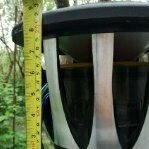-
Posts
2392 -
Joined
-
Last visited
-
Days Won
139
Dafaseles last won the day on December 17 2022
Dafaseles had the most liked content!
About Dafaseles

- Birthday 09/28/1982
Contact Methods
- Yahoo
Profile Information
-
Gender
Male
-
Location
510
-
Interests
Car audio
Recent Profile Visitors
Dafaseles's Achievements
-

Cost wise on power wire?
Dafaseles replied to jessdabest77's topic in Electrical-battery- Alternators- Wiring
Welding cable is technically fine. As long as it's pure copper, it's just not oxygen free copper. From what I've read, welding wire is more susceptible to corrosion than car audio cable, but I've never tested this myself. Welding wire does go by the AWG scale, and car audio cable is oversized, so if you need 1/0 awg car audio cable, 2/0 welding wire would be the same size and about the same amp rating. -

No distortion detected…
Dafaseles replied to Chug Wysley's topic in SMD Distortion Detector (DD-1) Topics
Try also using a 1000 hz tone to see if you get different results -

No distortion detected…
Dafaseles replied to Chug Wysley's topic in SMD Distortion Detector (DD-1) Topics
How do you have the Lc7i hooked up? Are you sure you're sending all frequencies through it? Have you tried to find max volume with a 1000 hz test tone? If you're getting your high level input from someplace that the OEM unit isn't sending a full signal to, you might not be getting 40 hz through the equipment. Let's say someone is getting their high level input from factory tweeters. Well, the OEM system isn't going to send all the frequencies through that speaker, so the LOC won't get it either, thus making it so the DD-1 doesn't detect it. LOC's like the Lc7i have multiple inputs so on complex stock systems that send different crossed over signals to different speakers, you can take all those, feed them into the LOC individually, and the Lc7i will sum up the different frequencies to make them one cohesive...... unit I guess you could say. Also, when we set the gains in my buddies system with the Lc2i, we had to set the accubass first as well to compensate for the bass roll off. If I'm not mistaken, in the DD-1 manual, or says turn the gains all the way down (I could be mistaken), but I've had good luck with just barely cracking the gain a hair. On another note, once you get it working, set the head unit and LOC gain using a 0 db tone, then set your overlap just on the amplifier -

No distortion detected…
Dafaseles replied to Chug Wysley's topic in SMD Distortion Detector (DD-1) Topics
Are you using the 0 db 40 hz tone to find the max volume of the head unit and set the gain on the LC7i? -

No distortion detected…
Dafaseles replied to Chug Wysley's topic in SMD Distortion Detector (DD-1) Topics
First, try changing the batteries to a strong, name brand battery. It might sound stupid, but I've seen it work more than once. Second, did you make sure your crossovers aren't overlapping? Make sure your low pass filter is set as high as you can, and your subsonic is set as low as you can. -
Done in the right conditions, right enclosure, electrical all the way correct, gains and crossovers set perfectly.... maybe. But I'm not going to give someone the advice to throw that kind of power at it because if they end up blowing the sub because of over powering it, I'm not going to warrantee that shit🤣
-

Fluctuating voltage
Dafaseles replied to mdnjmmy0613's topic in Electrical-battery- Alternators- Wiring
I don't know if I told you, but after all that, I spoke with Tony from mechman. For GM trucks, they make a whole bypass setup that also will fool the charging system into thinking the VRC is still in control. No battery light on the dash, and a constant 14.7v from the alternator. I had to order a new alternator though. A 2 pin input instead of a 4 pin. With the max charge of the Cyber 12k betting 14.8v, the constant 14.7 will be way safer than the fluctuating voltage from the VRC. -

Fluctuating voltage
Dafaseles replied to mdnjmmy0613's topic in Electrical-battery- Alternators- Wiring
My truck has one a well. What i've learned is that it's important to not send grounds to the engine block/ alternator without passing through the "ring" first. You can ground to the frame, but the frame grounds should come back up to the negative battery terminal, then through the ring, then to the block. If you pass by the ring, it can cause havoc on the system. What actually happens? I don't know. Just read "don't do it" lol. -

Fluctuating voltage
Dafaseles replied to mdnjmmy0613's topic in Electrical-battery- Alternators- Wiring
Steady voltage at night might have something to do with the headlights and taillights. At night, the automatic lights will turn on all the lights needed for night driving. In turn, the voltage controller says "well then we'll need more voltage", and at accordingly. Try turning your lights from automatic, to just flat out on during the day, and see what results you get. -

Wire Size for 400 amp Alternator Upgrade
Dafaseles replied to Time2SHO's topic in Electrical-battery- Alternators- Wiring
So yeah, you're not pulling much, but those high end JL amps are hungry. That alternator with even your current battery is more than enough. 1 big 3 will be plenty right now. Though 2 runs of 1/0 from your alternator positive to your battery won't hurt. I say that just to be a little overkill, so you won't ever exceed the rated amperage of the cable. Mechman rates their alternators at 1800 RPM. So at 1800 RPM, that alternator can put out 400ish amps (I have one as well) and at 800 RPM (about idle) they usually put out around 200ish amps. So that can kind of give you an idea of how much current that alternator will be pushing out the majority of the time while driving. Good 1/0 OFC car audio cable is usually rated around 350 amps. I always tend to try and steer people away from using CCA car audio cable because, basically, it's cheap, and can't handle the amperage OFC can. Welding cable is pure copper, which in my opinion, is just fine to use in daily driver systems, with some asterisks. Car audio cable is oversized, so it can handle more. Welding cable uses the AWG standard. So 1/0 welding cable is usually rated around 300 amps. Also, depending on who you ask, the cable sleeve of welding wire can be less protective than car audio cable (I have never tested this claim). Some say OFC is even more resistant to oxidation than pure copper (I've never tested this myself either). If you ever get to put in a second HD1200.1, then I would recommend dropping coin on 2 high output AGM batteries. Replacing your current battery and your truck has space and kits to add a second battery under the hood, so finding space shouldn't be an issue. That should keep both fed just fine. The reason I like those type battery terminals is, at least for me, it was easier to attach all the ring terminals I needed, and liked a lot cleaner, than stacking everything together on a "pole". -

Wire Size for 400 amp Alternator Upgrade
Dafaseles replied to Time2SHO's topic in Electrical-battery- Alternators- Wiring
It's a fun hobby, but one that can get expensive, just like fixing up a car lol. By industrial cable, do you mean welding cable? As far as getting into it deeper than you expected, you do it right the first time, you won't have to worry about anything in the future. If you don't mind me asking, what gear are you running? Amp, and subs specifically. 2nd battery? In the interest of keeping things clean looking, I prefer something more like this https://skyhighcaraudio.com/copy-of-sky-high-car-audio-6-flat-battery-terminals/ Or input style of you prefer https://skyhighcaraudio.com/sky-high-car-audio-sae-4-0-xl-2-0-xl-or-1-0-4-input-set-screw-battery-terminal/ They make different sizes and different configurations. This is just to give you an idea. And to expand on what @TheBKGsaid, I think he's referring to something like these https://skyhighcaraudio.com/sky-high-car-audio-dual-1-0-to-1-0-gauge-inputs/ They also come in different sizes and configurations as well -

Wire Size for 400 amp Alternator Upgrade
Dafaseles replied to Time2SHO's topic in Electrical-battery- Alternators- Wiring
What battery do you have under the hood now, so I can see a picture of what you're referring to. Yeah, that 8/0 is hood, and expensive. I thinks it's $1000 for 50 ft lol. I was just throwing that out there because I thought it was interesting. 2 runs of 1/0 is rated higher than 1 run of 4/0, so you can go wrong with 2 runs of 1/0. Just of you REALLY wanted to have just a single run, 4/0 will handle it. -

Wire Size for 400 amp Alternator Upgrade
Dafaseles replied to Time2SHO's topic in Electrical-battery- Alternators- Wiring
This is what I used on mine. Very convenient and clean looking https://skyhighcaraudio.com/alternator-distribution-block-1-0-shca-ring-terminal/ Also, there is 4/0 wire out there. Sky high makes some good stuff and so does knukonceptz. If you feel froggy, Shok Industries makes an 8/0 lol -
Just a thought, I don't know if it would make that much of a difference or not, just throwing it out there.... Would varying voltages to the amplifier effect current draw as well? If his vehicle has some sort of stock voltage regulating system that will send a lower voltage out than his buddies vehicle? Like I said, I don't know if that would really make that huge of a difference









